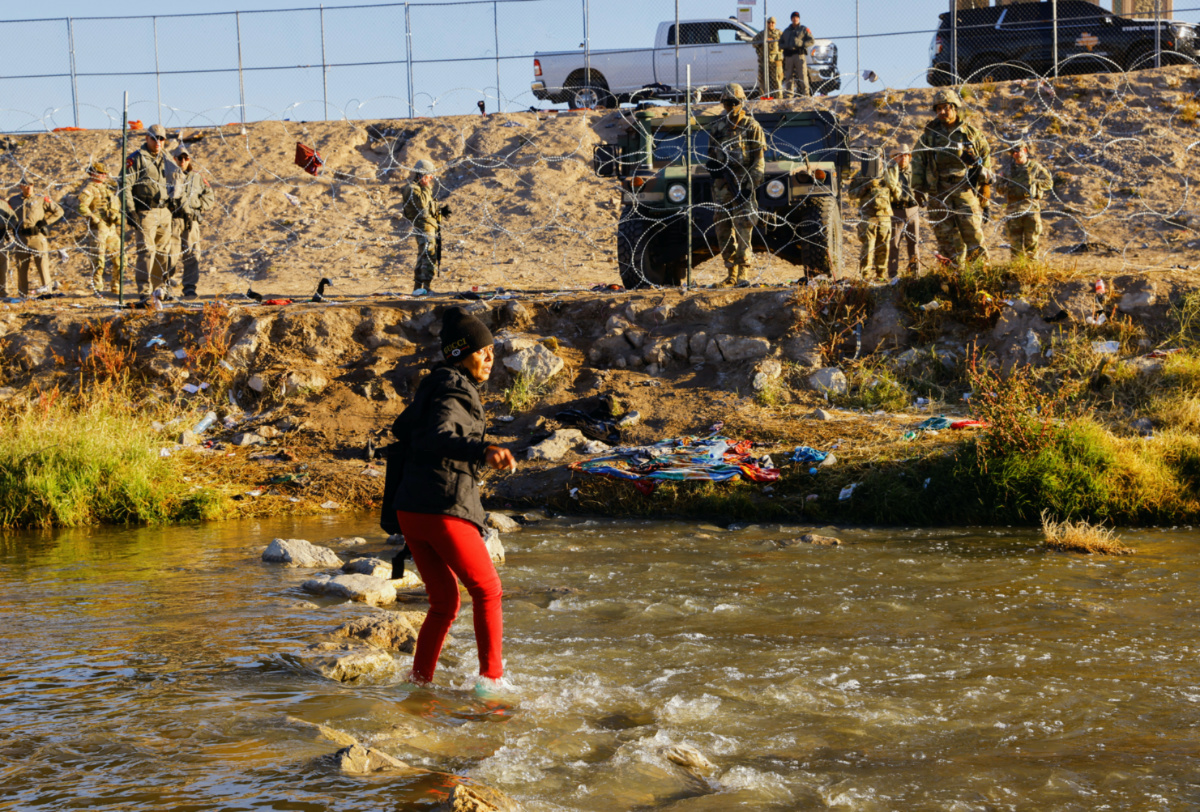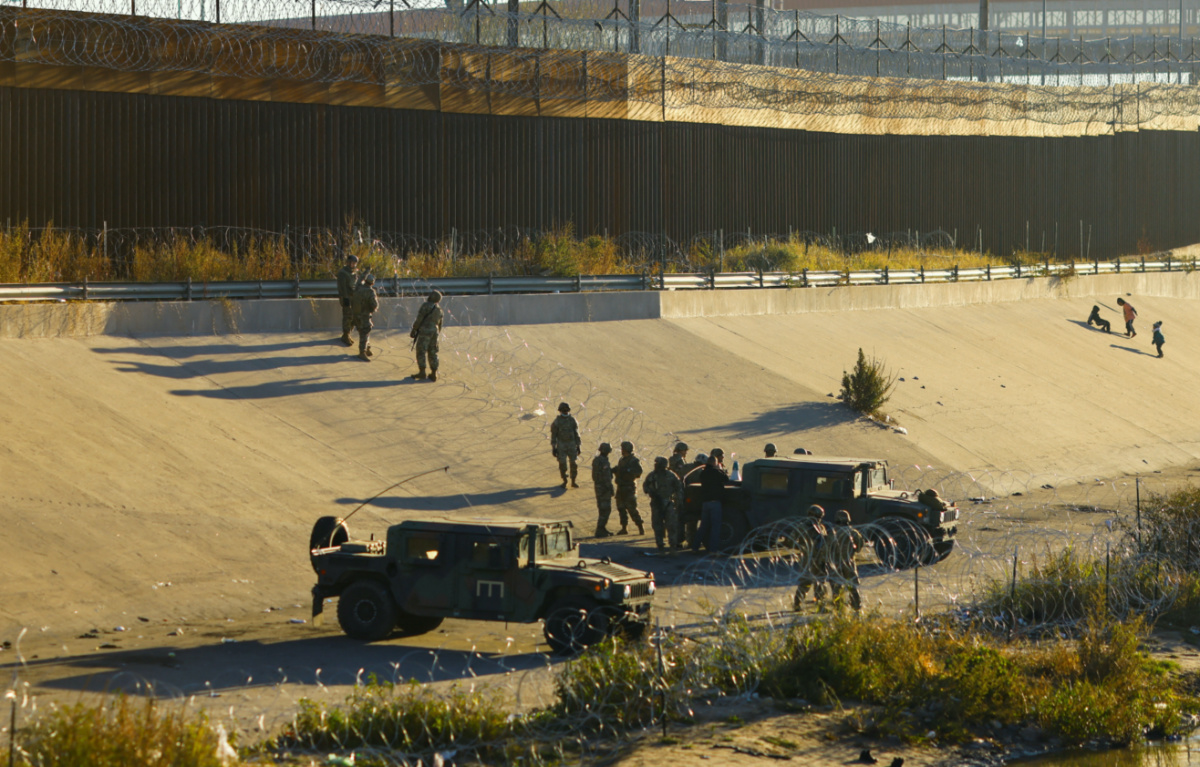Ciudad Juarez, Mexico/Washington DC, US
Reuters
When Vladimir Castellanos learned that COVID-19 restrictions blocking him and other migrants from claiming asylum at the US border with Mexico may not be terminated this week, he said he felt deceived.
Castellanos and his brother are Venezuelans, and they were among dozens of migrants gathered on both sides of the Rio Grande on Monday night in Ciudad Juarez, Mexico, and El Paso, Texas, with some lighting small fires to keep warm as temperatures dropped toward freezing.

A migrant asylum seeker tries to cross the Rio Bravo river to request asylum in El Paso, Texas while Police Texas State Troopers and members of the Texas National Guard stand guard on the banks of the Rio Bravo river, the border between the United States and Mexico, with the purpose of reinforcing border security and inhibiting the crossing of migrants into the United States, after the US Supreme Court said Title 42 should stand as is for now, seen from Ciudad Juarez, Mexico, on 20th December . PICTURE: Reuters/Jose Luis Gonzalez
They had traveled there in anticipation that the COVID-19 restrictions, known as Title 42, would be lifted on Wednesday as ordered by a US court. Title 42 allows US authorities to rapidly expel migrants to Mexico and other countries without a chance to seek US asylum.
But in an last-minute move, the US Supreme Court on Monday allowed Title 42 to remain in place temporarily while a Republican legal challenge seeking to extend the measures is decided.
“I view it as a joke, to give us hope and then, like a child, trick us and tell us that they are going to postpone,” Castellanos said, adding that it was unfair that migrants from other countries could enter the United States while Venezuelans were barred.
Under Title 42, the United States typically can only expel migrants from Guatemala, El Salvador, Honduras and Venezuela to Mexico. Mexico won’t accept Nicaraguans, for example, or migrants from certain South American countries, who generally have been allowed into the United States to pursue their immigration cases.
Since Biden took office in January, 2021, about half of the record 4 million migrants encountered at the US-Mexico border have been expelled under Title 42 while the other half have been allowed into the country.
Razor wire barrier
The rise in people crossing the border has overwhelmed some border communities. The city of El Paso, Texas, declared a state of emergency over the weekend as hundreds of migrants were on the streets.
The migrants interviewed by Reuters were a handful of the estimated tens of thousands waiting on the Mexican side of the border for a chance to cross.
Early on Tuesday, dozens of Texas National Guard troops in camouflage uniform and helmets fanned out at the border between Ciudad Juarez and El Paso in armored cars. The troops, part of a larger deployment of 400 personnel, unspooled long lengths of concertina wire to create a barrier alongside the river.

Police Texas State Troopers and members of the Texas National Guard stand guard on the banks of the Rio Bravo river, the border between the United States and Mexico, with the purpose of reinforcing border security and inhibiting the crossing of migrants into the United States, after the US Supreme Court said Title 42 should stand as is for now, seen from Ciudad Juarez, Mexico on 20th December. PICTURE: Reuters/Jose Luis Gonzalez
Title 42 was originally issued in March, 2020, under Republican former President Donald Trump at the beginning of the COVID-19 pandemic. The administration of US President Joe Biden, a Democrat, left it in place for more than a year and expanded it in October to include Venezuelans in the expulsions to Mexico while also allowing up to 24,000 Venezuelans to enter the United States by air if they apply from abroad.
Still, the Biden administration says it wants Title 42 to end after US health authorities said in April that the order was no longer needed to prevent the spread of COVID-19.
A federal judge ruled in November that Title 42 was unlawful and ordered it lifted on 21st December, siding with asylum-seeking migrants who sued the government over the policy.
But a group of 19 states with Republican attorneys general mounted a legal challenge to keep Title 42 in place by seeking to intervene in the suit. The US Supreme Court on Monday said the restrictions should remain for now and asked the parties to file responses to the states’ challenge by 5pm EST on Tuesday.
Some Venezuelans on the Mexican side of the border were still holding out hope for a change.
“I can’t give up so easily,” said 26-year-old Venezuelan migrant Alexis Farfan, who has been staying at an LGBTQI+ shelter in Tijuana since he was expelled from the US earlier this month. “I trust in God that I will get to the other side.”
– Additional reporting by JACKIE BOTTS in Oaxaca City, Mexico






